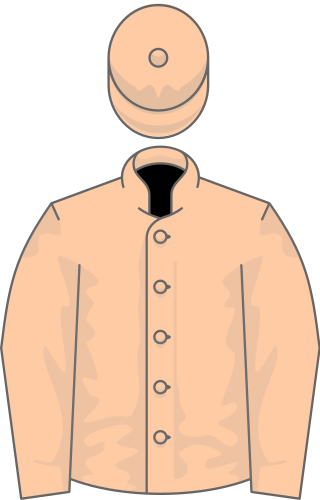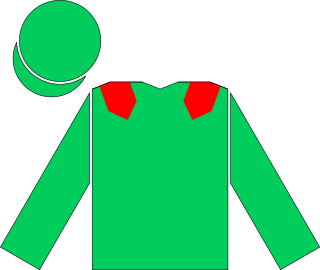
Slip Anchor (1982–2011) was a British Thoroughbred racehorse best known for winning the 1985 Epsom Derby by seven lengths. After showing some promise as a two-year-old, he showed substantial improvement in the spring of 1985, winning the Derby Trial at Lingfield Park Racecourse by ten lengths before recording a rare start-to-finish win in the Derby. He was rated the best racehorse in Europe in 1985. His subsequent career was disrupted by injury, and he finished second in his other three races before being retired to stud. He had some success as a breeding stallion and died in 2011.

Shaamit (1993–2001) was an Irish-bred, British-trained Thoroughbred race horse and sire. In a career which lasted from September 1995 to October 1996, he ran six times and won twice. He was the winner of the Epsom Derby in 1996. He was retired to stud at the end of his three-year-old season where he had limited success. He died in 2001.

Henbit was an American-bred and British-trained Thoroughbred racehorse, best known for winning the Derby in 1980. After winning one minor race as a two-year-old, he showed improved form in 1980 to win the Classic Trial Stakes and the Chester Vase. He won the Derby in a fast time but sustained a leg injury in the race which ruled him out for the rest of the year. He failed when returning as a four-year-old and was retired to stud, where he had limited success as a sire of winners.

Shirley Heights was a British Thoroughbred race horse and winner of the Derby in 1978. The colt had previously won the Royal Lodge Stakes and the Dante Stakes, and he went on to win the Irish Derby before his racing career was ended by injury. He became a highly successful breeding stallion.
Never Say Die (1951–1975) was an American-bred, British-trained Thoroughbred racehorse. After winning only once from his first nine races, he demonstrated much improved form in the summer of 1954 to win the Derby, becoming the first American-bred colt to win the race in 73 years. Later that year he added a second British Classic, when winning the St. Leger Stakes by a record margin of twelve lengths. He was later retired to a successful stud career.

Ard Patrick (1899–1923) was an Irish-bred, British-trained Thoroughbred racehorse and sire. One of the leading two-year-olds of 1901, he improved in 1902 to win The Derby, defeating the filly Sceptre. He returned from Injury problems to record his most important success when he defeated Sceptre and the Derby winner Rock Sand in the 1903 Eclipse Stakes at Sandown Park Racecourse. He was then retired from racing and exported to Germany where he became a successful sire of winners.
Hard Ridden (1955–1981) was an Irish Thoroughbred racehorse. In a brief career of five races, he won the Irish 2000 Guineas at the Curragh and the Derby at Epsom in 1958. He was retired from racing later in the same year and stood as a stallion in Ireland and Japan.

Airborne was an Irish-bred British-trained Thoroughbred racehorse and sire. After showing little worthwhile form as a two-year-old, Airborne improved to become one of the leading three-year-olds in Britain in 1946. He won five successive races including two Classics: the Derby at Epsom and the St Leger at Doncaster. He was the most recent of four greys to have won the Epsom Classic. Airborne went on to have a stud career of limited success.

Big Game (1939–1963) was a British Thoroughbred racehorse and sire. In a career that lasted from April 1941 to October 1942, the colt, who was owned by King George VI, ran nine times and won eight races. He was the best British two-year-old colt of his generation in 1941 when he was unbeaten in five starts. Two further wins the following spring including the 2000 Guineas at Newmarket took his unbeaten run to seven, but he suffered his first defeat when odds-on favourite for the wartime "New Derby". He won his only other race in the Champion Stakes before being retired to stud. Big Game's royal connections and racecourse success made him one of the most popular horses of his time.
Ile de Bourbon (1975–1997) was an American-bred, British-trained Thoroughbred racehorse and sire. In a career which lasted from 1977 until October 1979 he ran twelve times and won five races. His most important success came in July 1978 when he won the King George VI and Queen Elizabeth Stakes at Ascot. He was retired to stud in 1979 and sired the Derby winner Kahyasi.
Never Too Late was an American-bred, French-trained Thoroughbred racehorse. In a racing career lasting from August 1959 until October 1960, the filly ran nine times and won four races. As a two-year-old she proved herself capable of competing against the leading French colts by winning the Prix de la Salamandre at Longchamp and being narrowly beaten in the Grand Critérium. In the following year she was sent to Britain where she won the 1000 Guineas at Newmarket and Oaks at Epsom. She was then retired to stud at the end of her three-year-old season, and had some success as a broodmare.

William the Third (1898–1917) was a British Thoroughbred racehorse and sire. After finishing unplaced on his only race as a two-year-old in 1900, he won five times in 1901 as well as finishing second in The Derby. He reached his peak as a four-year-old, winning five consecutive races including the Ascot Gold Cup, Queen Alexandra Stakes and Doncaster Cup. His career was ended by injury in early 1903 and he was retired to stud, where he had considerable success as a sire of winners.

Doyoun was a British Thoroughbred racehorse and sire, best known for winning the classic 2000 Guineas in 1988. In a racing career which lasted from October 1987 until October 1988 he ran seven times and won three races. After winning his only race as a two-year-old in 1987, Doyoun produced his most impressive performance on his three-year-old debut when he defeated Warning in the Craven Stakes. He won the 2000 Guineas on his next appearance but failed to win again, although he did finish third in The Derby. He was retired to stud at the end of the season, and after a slow start to his breeding career, sired several important winners including Daylami and Kalanisi. He died in Turkey in 2002.
Darius (1951–1968) was a British Thoroughbred racehorse and sire, best known for winning the Classic 2000 Guineas in 1954. In a racing career which lasted from the spring of 1953 until November 1955 he ran twenty-one times, won nine races and was placed on ten occasions. He was one of the best British two-year-olds of his generation, winning four races including the July Stakes and the Champagne Stakes. In the following year he won the 2000 Guineas and the St James's Palace Stakes, finished second in the Eclipse Stakes and third in both The Derby and the King George VI and Queen Elizabeth Stakes. He won three more races as a four-year-old including the Eclipse Stakes. After a disappointing run in the Washington, D.C. International Stakes he was retired to stud where he had considerable success as a sire of winners.
Niksar (1962–1980) was a French-bred, British-trained Thoroughbred racehorse and sire, best known for winning the classic 2000 Guineas in 1965. After failing to win as a two-year-old he won his first race of 1965 by six lengths before winning the Guineas at Newmarket Racecourse. He failed to win in his remaining five starts and was retired at the end of the season with a record of two wins and two places from ten starts. He had moderate success as a breeding stallion in Australia and Japan.
Thunderhead was a French Thoroughbred racehorse and sire, best known for winning the classic 2000 Guineas in 1952. He won once as a two-year-old and showed improved form in the spring of 1952, winning the Prix de Fontainebleau before recording an emphatic win over twenty-five opponents in the 2000 Guineas. He then finished second when favourite for the Poule d'Essai des Poulains and ran poorly when strongly-fancied for The Derby. He was later exported to South Africa where he had some success as a breeding stallion.
Tehran (1941–1966) was a British Thoroughbred racehorse and sire, who raced during World War II and was best known for winning the classic St Leger in 1944. After showing little ability as a two-year-old he improved in the following spring to win the Culford Stakes on his three-year-old debut. He ran third in the 2000 Guineas and was narrowly beaten into second place in the Derby Stakes. After winning the Whepstead Stakes he recorded his biggest win when defeating a strong field in a substitute St Leger. He won his first three races in 1945 and finished second in the Ascot Gold Cup. He later became a successful breeding stallion, siring several major winners including Tulyar.

Doricles was a British Thoroughbred racehorse and sire. Although he ran only twice as a two-year-old in 1900 he showed considerable potential when he dead-heated for first places in the July Stakes. In the following year he was a consistent performer at the highest class who contested all three legs of the Triple Crown. He finished second in the 2000 Guineas and the Newmarket Stakes but disappointed when coming home seventh in the Epsom Derby. He ran second again on his next start, before winning his next three races, culminating in a 40/1 upset victory in the St Leger Stakes. He failed to win again and was retired to become a breeding stallion in France.
Ellangowan was a British Thoroughbred racehorse and sire. He raced only once as a two-year-old but showed considerable promise when finishing third in a top-class event at Kempton. In the following spring he came in third in the Craven Stakes before recording his biggest win in the 2000 Guineas. Although be made no impact in the Epsom Derby or the St Leger, he had further major victories in the St James's Palace Stakes Champion Stakes. He failed to win in 1924 and was retired to stud, but had little success as a breeding stallion.

Aida was a British Thoroughbred racehorse and broodmare. As a juvenile she finished second on her debut and then defeated the future Epsom Derby winner Volodyovski in the Imperial Produce Stakes. She won the 1000 Guineas on her first appearance of 1901 and then finished a close third in a very strong edition of the Newmarket Stakes. She finished unplaced in the Eclipse Stakes and the St Leger and was retired from racing at the end of the year. As a broodmare she had an enduring influence on the breed through her daughter Herself.











